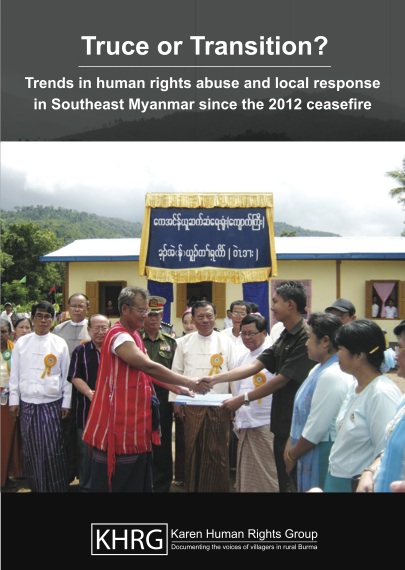Truce or Transition? Trends in Human Rights Abuse and Local Response in Southeast Myanmar Since the 2012 Ceasefire
By Karen Human Rights Group • May 14, 2014In January 2012, the Myanmar government and the Karen National Union (KNU) signed a preliminary ceasefire agreement, bringing to a halt what is often referred to as the world’s longest-running civil war. This conflict engendered severe human rights abuse of civilians at the hands of a range of armed actors, primarily at those of the Myanmar Armed Forces (Tatmadaw). The ceasefire and other recent political developments in Myanmar have altered the ways in which human rights abuse is experienced by Karen people in the Southeast, and transformed the context within which these abuses can be addressed. This report aims to demonstrate how trends in human rights abuse have changed during the post-ceasefire period.
KHRG has drawn on 388 pieces of documentation and 162 sets of images collected by KHRG researchers between January 2012 and November 2013 from across the seven locally-defined Karen districts, which spread across Kayin and Mon states and Bago and Tanintharyi regions.
This report focuses on three main sets of trends that were identified from this data. The first category, “Trends in human rights abuse and local response”, consists of nine human rights issues, namely, attacks on civilians and extrajudicial killing; arbitrary arrest and detention; torture and violent abuse; rape and sexual assault; forced labour; forced recruitment; anti-personnel and other mines; restrictions of freedom of movement; and arbitrary taxation and demands.
The second category includes two emerging issues related to “Resource management”, namely, land confiscation; and negative consequences of infrastructure and commercial development. The third category includes five emerging issues related to “Security, peacebuilding and social cohesion”, namely, ongoing militarisation and resulting perceptions of insecurity; the impacts of peacebuilding efforts; access to health and education; religious and ethnic discrimination; and drug production, use and related social impacts.
Rationale for the report
Since 2011, the Myanmar government has undertaken a rapid liberalisation process. It has passed new laws that allow greater space for peaceful assembly, improved labour rights and broader political participation and made new commitments to international agencies to address a number of human rights related issues in rural ethnic areas. Meanwhile, the Government has pursued ceasefires with ethnic armed groups (EAGs) throughout the country. Ceasefires signed with Karen EAGs have transformed the security environment on the ground in Southeast Myanmar. As the Government becomes more open to discussion of human rights challenges, and a wide array of new external actors enter Southeast Myanmar, many local and international stakeholders have significant gaps in their knowledge of these challenges.
Since the ceasefire, local perceptions of threats to the ceasefire process have not been systematically documented. Local priorities for change and locally preferred solutions remain similarly unknown. As new actors become active in the peace process, greater awareness of the perspectives of conflict-affected communities will become critical to achieving a lasting solution. Further, there are a number of under-reported negative consequences of the ceasefire process, which represent significant obstacles to a lasting peace.
This report therefore aims to address these gaps by providing an update from the ground in rural Karen areas of Southeast Myanmar that will allow national and international actors to base policy decisions related to the post-conflict region more closely around the experiences of local people, and better support villagers by understanding their concerns and priorities.
Key findings
According to KHRG documentation of human rights trends since January 2012:
- The ability to travel more freely was the most frequently reported change to villagers’ lives and livelihoods.
- The construction or fortification of army bases as well as increases in rations transportations, have caused villagers to feel that their personal security is threatened, and to doubt that the ceasefire is sustainable.
- There have been no large-scale, coordinated military attacks targeting civilian settlements.
- Civilians accused of supporting EAGs continue to be arbitrarily arrested, detained, violently abused, tortured and targeted in isolated armed attacks by Tatmadaw and BGFs.
- An overall decrease in Tatmadaw demands for forced labour was reported. In some areas Tatmadaw and BGF battalions continue to demand forced labour on a regular basis.
- An increase in the production and sale of narcotics by BGF commanders was reported, which is likely due to the relative ease of travel.
- Profit-making activities of armed actors have led to various forms of human rights abuse. Broadly speaking, these relate to the BGF’s drug production and levying of taxes for soldiers’ salaries, the Tatmadaw’s involvement in the expropriation of land, and various forms of arbitrary taxation, imposed by all armed actors, including the KNLA and DKBA.
- Villagers described an increased sense of freedom to report cases of land confiscation to local authorities in the ceasefire period and responded collectively to such abuses.
- Following communal violence in Rakhine State, distribution of rules restricting interaction between Muslim and Buddhist communities in two research areas was carried out by religious leaders and BGF personnel, increasing tension in those communities.
- Armed actors have largely stopped planting new anti-personnel and other mines in most areas. Residual mine contamination continues to cause death and injury and restrict freedom of movement and livelihoods, despite persistent requests for their removal by some communities.
This post is in: Business and Human Rights, Spotlight
Related PostsBurma Army Displays Blatant Disregard for 21st Century Panglong Peace Process
Karen State September 2016 Conflict: The Real Motivations Behind Renewed War
Burma Army’s actions in Karen State threaten to expand fighting, endangering peace process and displaced people’s return
Hpa-an Situation Update: Hlaingbwe and Paingkyon townships, March to May 2016
Legal Analysis Statement on current armed conflict in Karen State from the perspective of human rights and the rule of law vis-a-vis the Nationwide Ceasefire Agreement










 All posts
All posts